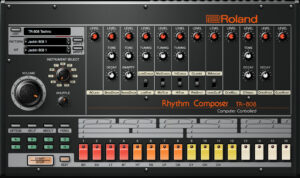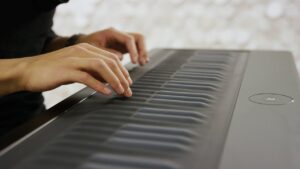Music production is vastly more accessible now than it has ever been. A large part of this is due to advances in technology. Things that were once prohibitively expensive, or in some cases too large, are now readily available and often within the average consumer’s price range.
The need for physical gear also continuously decreases, as the once-prized circuit boards with their imperfect soldering, are now perfectly emulated in digital plugins. As well, the ‘human’ aspect of playing an instrument can be algorithmically replicated, eliminating the need for studio musicians.
All this being said, there is a certain joy in the tactile manipulation of buttons and levers. Below, in no particular order, is our list of iconic or interesting pieces of music tech, both past and present.
Roland Tr-808
 When talking about iconic pieces of gear that became digitized, there’s none more ubiquitous than the Roland Tr-808. The term ‘808’ no longer even refers to the drum machine itself, or even specifically to the sounds that the machine makes. ‘808’ has become its own category of bass/kick, a unique sound that now permeates music culture.
When talking about iconic pieces of gear that became digitized, there’s none more ubiquitous than the Roland Tr-808. The term ‘808’ no longer even refers to the drum machine itself, or even specifically to the sounds that the machine makes. ‘808’ has become its own category of bass/kick, a unique sound that now permeates music culture.
Interesting then, that the Tr-808 was not an immediate commercial success when it was released in the early 1980s. This was despite being one of the first drum machines that allowed for the programming of the user’s own patterns, a feature that is practically universal now.
While this programmable feature was what drew Marvin Gaye to use the machine on “Sexual Healing,” the machine’s first appearance on a hit record, it wasn’t until much later, when the heavily discounted machines were resold into the hands of underground hip hop producers, that the sound we know so well today really took off.
TONTO
I wanted to include some sort of modular synth on this list, because while I can’t say I really understand them, they certainly look intriguing. Why not then talk about TONTO, short for “The Original New Timbral Orchestra”, the world’s largest multi-timbral polyphonic analog synthesizer, designed by Malcolm Cecil.
Not only is the machine impressive because of its sheer size, but also because its creation was the first attempt to make multiple analog synths talk to each other in some kind of “universal” language. This essentially created really huge interesting patches by combining different analog machines’ capabilities.
TONTO has appeared on all sorts of award-winning music from the likes of Stevie Wonder, The Doobie Brothers, and Quincy Jones, and has been used on many movie scores. Stevie Wonder actually listed Malcolm Cecil as an associate producer on his album because of TONTO, and so Cecil has received a Grammy for his work.
Roli SEABOARD
There are many advantages to the piano/keyboard as an instrument. For one thing, there are a lot of buttons, and you use all 10 of your fingers to press them, not to mention your feet. This leads to the ability to create both harmony and melody at the same time, something which not a lot of other instruments can boast. Music theory is a lot easier to grasp with an understanding of the piano. You don’t have to carry your instrument up the huge staircase to the backstage entrance, they just put it in the concert hall for you. The list is practically endless.
One major disadvantage that the piano has however, is the difficulty in making it sound “beautiful”. What we think of as “emotion” or “playing with feeling” is really just variations in sound that our ear is trained to notice and like. This could include things like dynamic variance, changes in timbre, the shape of the sounds transient etc. A piano, because it is a percussion instrument, is only capable of dynamic changes. It tries for more, though … you have pedals that will shift the entire keyboard to hit fewer strings, or that will completely remove dampening for lots of sustain. There are countless phrase markings and articulations, but nothing will change the fact violinists just have to wiggle their fingers to get the same level of “emotion” that a pianist has to train years to achieve.
This is why the Roli SEABOARD is so interesting.
It is a MIDI device, that while having keys like a regular keyboard, is actually made out of a flexible material that allows for much more of a gradient in sound than regular keyboard action. It also gives the ability to perform vibrato. These features put a much wider range of options under a pianist’s fingertips.
keys like a regular keyboard, is actually made out of a flexible material that allows for much more of a gradient in sound than regular keyboard action. It also gives the ability to perform vibrato. These features put a much wider range of options under a pianist’s fingertips.
The Roli SEABOARD could be the next obvious evolution of the keyboard. I look forward to the day that musicians begin performing on it, and pedagogical institutions and composers begin to take it seriously.
EMT 250 Reverberator Unit
Back in the early days of recording, the method to create artificial reverb on tracks was simply to build a room that reverberated the way you wanted it to. This wasn’t really “artificial” reverb, more like controlled or designed natural reverberation. It was really just a fancy version of recording in your bathroom, like The Harmonicats did for the first use of “chamber reverb” on the track “Peg o’ My Heart.”
Soon however, actual artificial reverberation was being achieved by mounting pickups to large plates or springs, and recording the vibrations they made when hit by sound.
In the somewhat unintended theme of this list, the simulated delaying and recording of source sound was then digitized and controlled by an algorithm. The first to do so was the company EMT with their 250 Reverberator Unit.
This brings us back to the joy in the tactile manipulation of buttons and giant levers! It is also an interesting segue into how a lot of sci-fi movies of the time period would use music recording gear as set dressing. There are many compressors or delay units pretending to be spaceship parts in some of your favourite nostalgic episodes. But perhaps that is a topic for another time.
If you are interested in learning how to manipulate the buttons and levers in a recording studio, check out our courses in Audio Production.




